Disclaimer: This product was sent to us for free, in exchange for a review. We were not paid by Jackery to do this review but we did receive it for free. All opinions expressed in this post are based on our personal views and experiences.
Is The Jackery SolarSaga 100W The Best Portable & Foldable Solar Panel?
We recently reviewed the Jackery Explorer 1000, which is a portable power station not only for travelers but also homeowners that want to have a backup power source in case of an emergency.
Jackery also makes solar panels that pair well with its batteries, so in this post, we’re going to review their most popular portable and foldable solar panel the Jackery SolarSaga 100W (click to view on Amazon).
You can tell by its name that it’s a 100W solar panel, but Jackery also makes a smaller SolarSaga 60W (click to view on Amazon).
I always recommend the largest panel possible if you need a panel to recharge a portable power station/solar generator, but it’s good to have two options to choose from.
Related Post: Review Of The Jackery Explorer 1500 Power Station/Solar Generator
In this review, we’re going to take a close look at what the SolarSaga 100W is capable of, what power stations and devices it’s compatible with, and how it holds up to similar solar panels from its competitors.
We’ll also do some tests to see how well it performs when paired with different popular power stations.
The Jackery SolarSaga 100W Solar Panel
The SolarSaga 100W (click to view on Amazon) is currently the largest solar panel made by Jackery, and it’s easy to understand why they chose to make a 100W panel.
Solar panels rated at 100 watts are the most popular size when it comes to portable panels since it’s not too small and not too large.
They’re also capable of recharging a 500Wh power station, like the Explorer 500 (click to view on Amazon), within 8 hours.
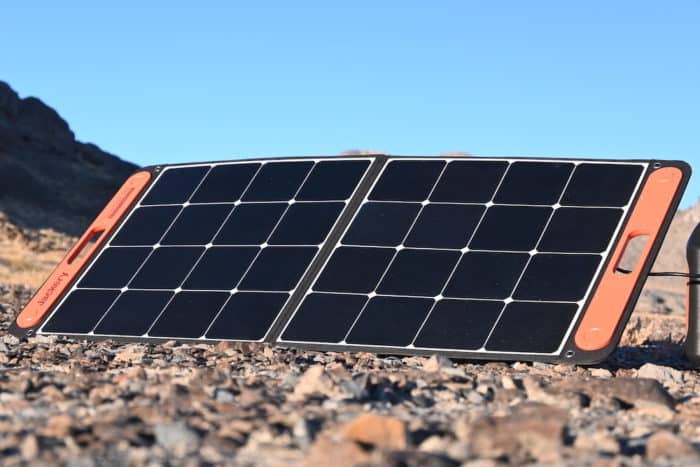
Some 100W panels are more portable than others, but Jackery has found a good balance between portability and functionality with its SolarSaga 100W.
The reason I say that is because it’s lightweight, portable, and has several outputs, while also offering a built-in stand that’s sturdy enough to handle some wind.
It’s not as sturdy as the much heavier Renogy 100W suitcase solar panel (click to view on Amazon), but I believe the compromises are worth it to most travelers.
Features
A solar panel only has so many features, but let’s split it up into four different topics: Design, ports, compatibility, and portability.
Design
The SolarSaga panels are designed with portability in mind. With a slim layer of solar cells, which are covered with ETFE.
ETFE is a fluorine-based plastic polymer and a great lightweight alternative to glass. This material is not only lightweight and more flexible than hard plastic but also durable.
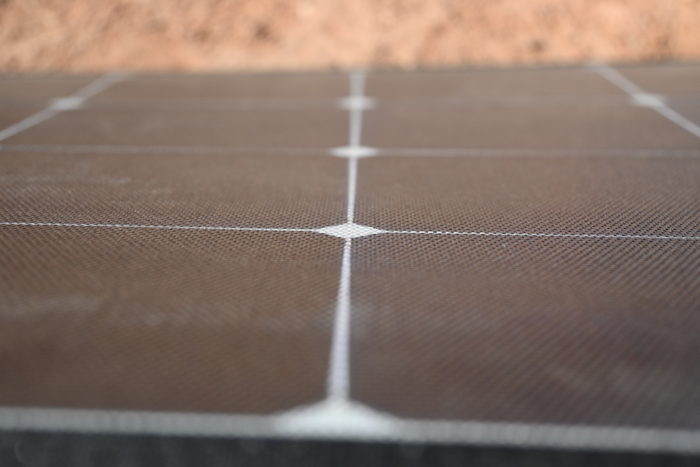
Along the sides, you’ll find two handles, one on each side, that meet up when you fold the panel together.
These handles are made out of TPE, which in this case is basically a mix of plastic and rubber.
There are also two magnets on each side instead of latches that keep the panel shut when folded together.
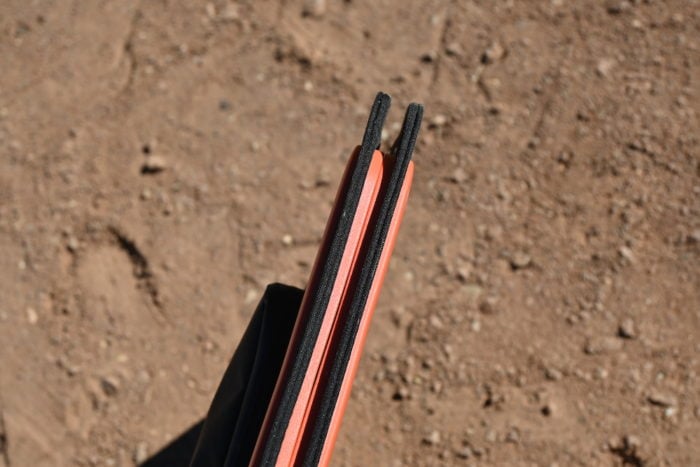
Along the sides, the corners, and the back of the panel, canvas fabric is used instead of plastic to make the panel durable yet lightweight.
It’s not a waterproof material, so it should not be left out in the rain.
See Also: Best Plastic Rugs & Mats For Outdoor, RV & Patio Use
The junction box and the 8mm cable are hidden within the large pocket on the back of the panel that has its own zipper.
It’s a relatively large pocket that can hold not only phones and small tablets but also portable power banks. Just be aware that it can get hot behind the panel.
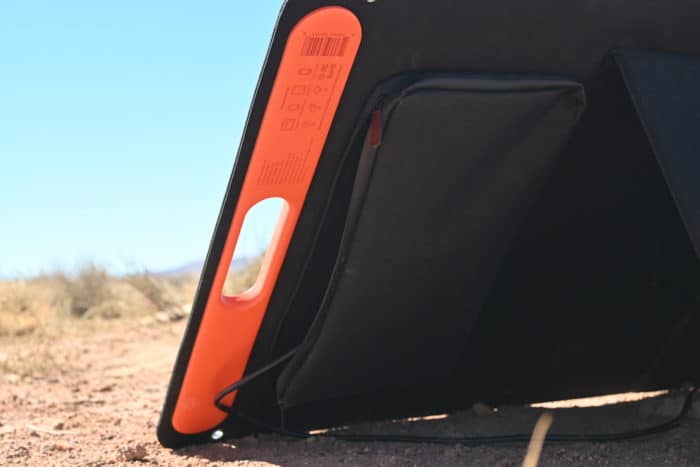
There are two built-in legs that function as a stand. These are held in place with velcro when folded, and with two straps when extended.
It appears that the legs have a piece of thick plastic covered by fabric to make them more sturdy.
One of the straps is an elastic band connected to the second strap to make it easier to fold the leg in without the main strap getting in the way.
It’s a genius design and something I haven’t seen (and been bothered by) on other similar panels.
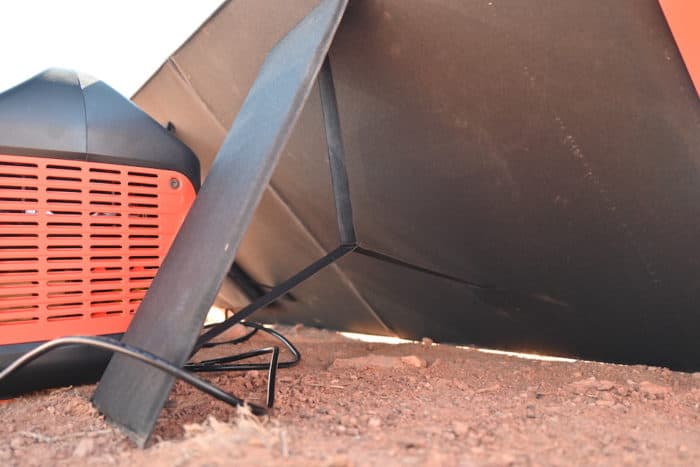
Last but not least, there are four holes, one in each corner, which make it easy to hang the panel up with rope or carabiners.
Ports/Outputs
The SolarSaga 100W has a junction box with a non-removable 10ft 8mm cable. That’s the input plug you’ll find on the Explorer power stations.
The panel can output up to 100W with a 23% cell efficiency.
But there is more to the junction box than the 8mm cable, there are also two USB ports. One USB A, and one USB C.
The USB A port can output up to 12W, and the USB C 15W. Note that the USB C port is not a PD port.
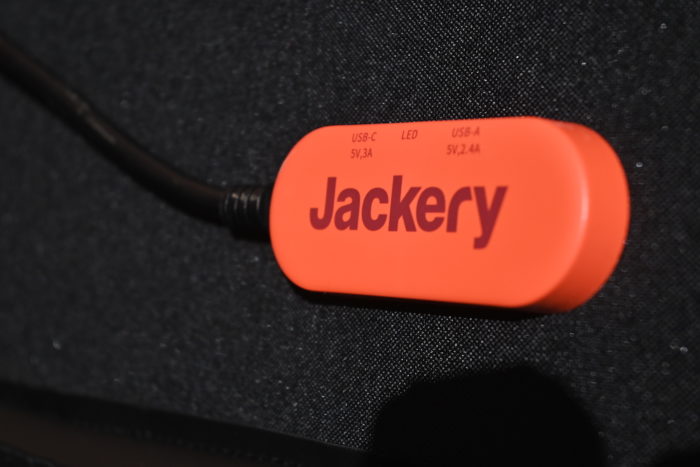
Between the USB ports, there is a small LED light that indicates whether the solar panel is generating electricity or not.
The output ratings and specifications of the panel and its ports are printed near the handle on the panel itself.
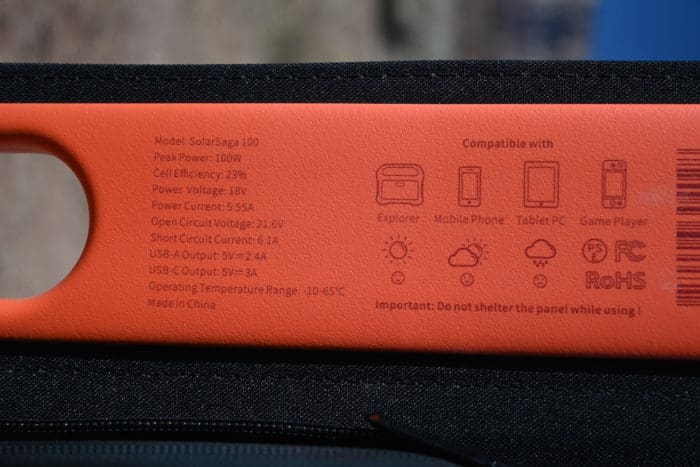
Compatibility
Since there is not only an 8mm plug but also two USB ports on the SolarSaga 100W, it’s compatible with a lot of different devices.
The 8mm input port can be found on Jackery Explorer power stations, Goal Zero Yeti power stations, Maxoak AC50 (click to view on Amazon), and several other power stations on the market.
With USB A and USB C ports, you can charge phones, tablets, speakers, cameras, lights, headlamps, etc. You can use both ports at the same time while also charging a power station.
Note that the USB C port is not a USB C PD port.
Portability
The SolarSaga 100W measures 24 x 21 x 1.4 inches when folded, and 48 x 21 x 0.2 inches when unfolded. It weighs 9.1 pounds.
What makes the panel so portable is the weight combined with its thin design.
Since there are no latches, metal legs, or heavy plastics, it’s easy to set up and pack away within seconds, and easy to carry due to the built-in handle.
It’s not the most portable 100W panel on the market since it only folds in half, but it’s the balance between portability and ease of use that make it stand out.
What I Like
The Design
I think Jackery has done an excellent job when designing the SolarSaga 100W panel. I have no big complaints that would stop me from buying this panel.
First, the kickstand design is genius with the strap that holds the second strap up to make it easier to fold the leg in.
Second, magnets! The panel folds together and holds itself together with magnets. No latches, no extra metal, just magnets doing their thing. It’s so easy to bring out and put away.
Third, the large pocket. This is the first solar panel I have tested that actually has a pocket large enough to be useful.
Even if you don’t want to leave your device in it while it’s charging, you can keep adapters, batteries, and whatever you choose to store in it.
How Well It Performs
I have tested several panels like the SolarSaga made by other manufacturers, and not a lot of them perform very well or even come close to the output they claim to be able to output.
This panel surprised me and performs well.
The Long 8mm Cable
The 8mm cable is about 10 feet long, and that’s longer than what most similar panels include. My only wish is that the 8mm cord could be disconnected from the junction box.
It’s The Complete Package
While I point at its different pros above, what I like the most is what the end product ends up being. A reliable, portable, lightweight solar panel that is easy to use.
Products can have a lot of features and bling, but what it comes down to is – which one do you end up using?
And I have found myself using the SolarSaga panels instead of my more portable Rockpals panel and the more sturdy Renogy panels.
Simply because of how easy they are to set up and put away.
What I Don’t Like
Fabric Picks Up Dirt And Dust
While the fabric helps keep the panel portable, it’s also really good at picking up dust and dirt.
Since it’s not a waterproof panel, you can’t spray it down, so you have to take a damp wipe and wipe the fabric down to clean it.
If it had a thin plastic frame on the bottom it would be easier to wipe it down each time you put the panel away.
Cable Can’t Be Disconnected
It can be seen as both a pro and a con depending on who you ask, but it would be nice to be able to disconnect the 8mm cable.
Not Waterproof
It doesn’t have a waterproof design. I believe it would be able to handle some light rain, but I wouldn’t leave it out in it for very long.
Most portable and foldable panels like this aren’t waterproof, so it makes sense.
Conclusion
I understand why the Jackery SolarSaga 100W is so popular, and I recommend it as a portable solar panel.
Paired with one of the Explorer power stations, it performs extremely well and is very straightforward and easy to use.
I see the SolarSaga panels as a challenge to other manufacturers to innovate their products.
Even though they might not be able to drastically improve the efficiency of the solar panels themselves every year, there are a lot of things they can do to improve the ease of use and other functionalities.
Each time I use it, I appreciate the small details and the thought the designers have put into it. It’s designed with the user in mind, and it shows.
Our Tests: Charging Popular Power Stations With The Jackery SolarSaga 100W
I connected the solar panel to all of the power stations I own to see how well it performs. This was done in Arizona near the end of October on a sunny afternoon (2 pm).
Here are the results:
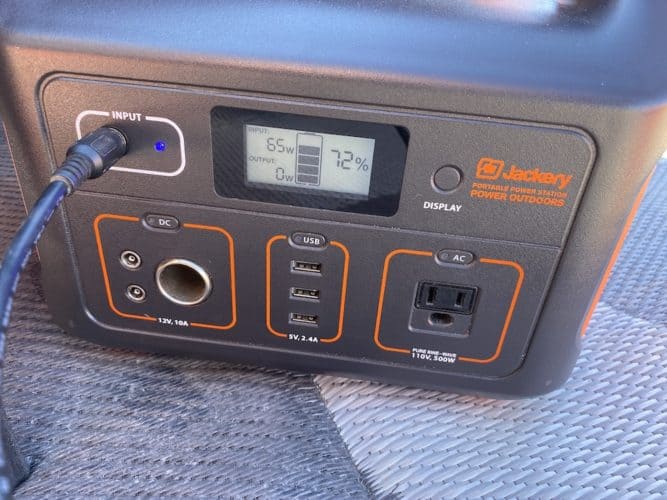
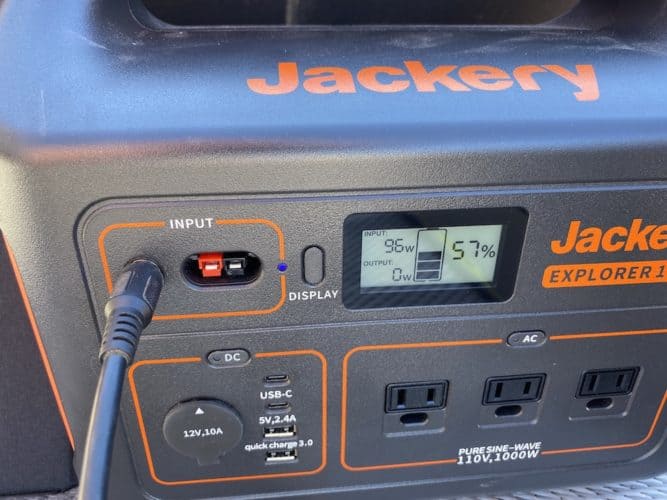
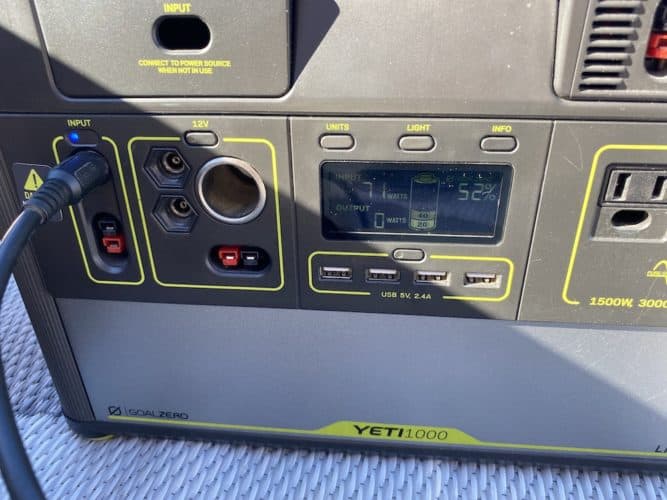
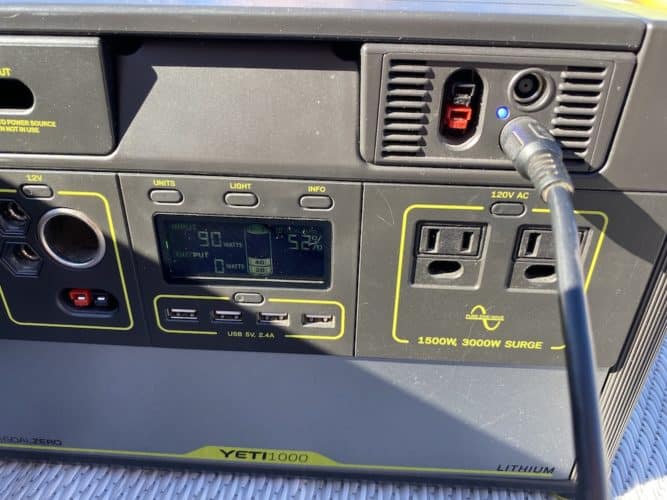
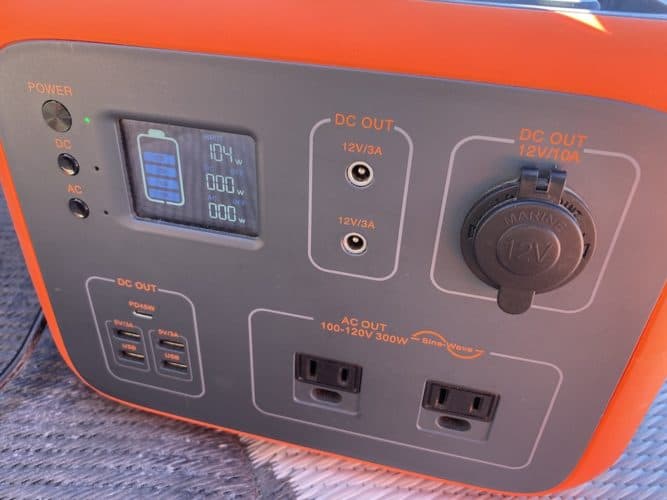
Frequently Asked Questions
Is The SolarSaga 100W Waterproof?
It’s not waterproof since there are open ports and connectors.
How Do You Connect Two SolarSaga 100W Panels Together?
To combine two SolarSaga 100W panels you need an 8mm Y branch. Jackery includes an 8mm to Anderson Y branch adapter with the Explorer 1000 power station (click to view on Amazon).
If you don’t have the Explorer 1000, you might have to make your own.
Can I Use A SolarSaga 100W With A Goal Zero Yeti?
Yes, since it uses the 8mm connector it’s compatible with the Goal Zero Yeti power stations that have an 8mm input.
Does It Work When It’s Cloudy?
Based on my tests, it can output from 5-50W depending on how cloudy it is and what time of the day it is.
A solar panel performs the best during peak sun hours, which is around noon, so if it’s a very cloudy morning or evening it will struggle to generate electricity.
Does The SolarSaga 100W Store Power?
No, the SolarSaga is only a solar panel. It doesn’t have a battery that stores the power.
To use the electricity that the panel generates, you must connect the 8mm plug to an external battery or a USB A/C cable to one of the ports and to a separate device.
Related Post: Best Portable Power Stations For Camping
Is There An 8mm Extension Cable I Can Extend The Cable With?
I have a pair of Graybull 8mm extension cables (click to view on Amazon) that work with the SolarSaga panels.
It doesn’t fit quite as snug as I would like, and a small pull on the cable disconnects it, but it works.
If you have any questions about the SolarSaga 100W solar panel, please leave a comment down below.


Hi Jesse, love your website. would I be able to hook up 2-120w togo solar panels to the Jackery 1000w charger? i understand hooking up the panels in parallel to lessen the voltage but not sure if the watts will be too much. i already have one Togo 12o watt panel. thanks for your help.
Rick
I haven’t tried it myself but technically it should work with an Anderson parallel connector. I found this kit (click to view on Amazon) which includes one, but I can’t promise it’s going to work.
I see that the panel includes “3m 30A to Solar Y Branch Connectors”, is that an Anderson to MC4 adapter? In that case, you could just get a pair of MC4 Y branches, then connect the MC4 to 8mm adapter and plug it into the Jackery.
The Jackery Explorer 1000 will handle 240W without a problem, but it does max out at around 126W input when using 12V solar panels so some of the generated electricity will be wasted. It can still be worth having two panels though if you live in a place that doesn’t get a lot of sunshine or has cloudy days.
Would using two saga 100w panels be worth the cost on a Jackery explorer 1000? I get a max of around 80 charging on one panel. Thanks in advance!
If you feel like it’s not charging quickly enough with just one panel and you need more electricity, absolutely. The extra 46 or so watts would make it possible to charge the Explorer from 0 to 100% in a full day of sunshine.
Thanks Jesse! I appreciate your advice. Great site by the way!
Also, can you mix panel brands like the Saga 100 and a Rockpals together or do you have to use the same brand panels? I figured if they were same specs they would work together but have found mixed answers on this.
Thanks!
Yes, I have mixed SolarSaga and Rockpals panels and it works great with the Explorer 1000. It might decrease the charge efficiency slightly because the output voltage will be based on the panel with the lowest voltage, but you should still be able to reach the 126W max with two different 100W panels.
I had to use the included 8mm parallel adapter since the Explorer 1000 only accepts input from one port at a time, but it worked with the 8mm connector on my Rockpals 80W, so it should work with the larger 100W panel as well.
You are a good communicator and educator for newbies like me. Last summer I bought a Explorer 1000 and a Rockpal foldable 100W for long home power outages so I could run a RV fridge and a DC fan. This year I wanted to get 2 of the new Rockpal 100W panels and use 3 panels since you wrote that 3 panels could be used to get the 1000 to its 126W max input but the panels are not available. So I ordered but have not yet received 2 Solarsaga 100W panels. You also wrote the Rockpal and the Solarsaga would work together welr and they are both 16-18 V. Since they are all 5.5 amps that would be a total of 16.5 amps and at 16-18 volts would be over 250 W. Does the 1000’s charge controller take care of that excess power? I am not sure how to connect them. I had planned to use the Anderson input with the 1000”s included Anderson Y branch. I am confused now about how to connect all 3. Do I use BougeR Y branch and how do I connect all 3 together and if so how many do I need? I know they should be in parallel to not exceed the 1000’s voltage limit. I am not very knowledgeable about all this or adept at putting things together so any info is appreciated
Hi,
Technically it should work, and the charge controller will regulate the amperage to a certain point as long as the voltage is within the limits. The max I have connected to my 1000 is around 15A and I haven’t had any issues. I usually stick to a total of 200W, since that’s enough to reach the 126W maximum.
I’m not sure it’s possible to connect three with the adapters available on the market though. Since there isn’t an 8mm combiner that works with the Jackery panels (as far as I know).
You could possibly use two 8mm female to MC4 adapters with the Jackery panels but I don’t know whether they will fit the connectors or not since not all 8mm are made the same.
If they do work, you’d combine all three panels (if your Rockpals has MC4 connectors) with an MC4 Y branch 3-to-1. Then you connect the Y branch to the Jackery with the MC4 to 8mm adapter.
But like I said, I can’t promise that these adapters will work together. I would just use the two Solarsagas with the 1000, and use the Rockpals to charge a smaller power station like the Explorer 160. Or you might be able to connect one Solarsaga and your Rockpals panel with the parallel adapter included with the Explorer 1000, and change the order/send one Solarsaga back.
When it comes to extension cables, I would use 10 or 12 AWG Windynation MC4 cables and hook them up between the MC4 Y branch and the MC4 to 8mm adapter.
Let me know if you have any questions.
I forgot to ask you about extension cables possibly up to 30 feet definitely 20 feet
How do you connect to a charge controller?
With one 100W panel, I’d get these three things to connect it to a 12V battery via a charge controller.
SolarEnz 8mm female to SAE connector (click to view on Amazon) – Connects to the Jackery panel
Allto Solar Intelligent 10A MPPT Solar Charge Controller (click to view on Amazon) – A great little charge controller that will connect to the adapter above.
YETOR 10 AWG Battery Alligator Clips (click to view on Amazon) – Connects to the charge controller and then the battery you want to charge.
Just make sure the polarity is correct the whole way (positive to positive, negative to negative)
Clicked on your link to the SolarEnz 8mm female to SAE connector, and I am going to give it a try. If it works I’m getting the rest.
The SolarEnz 8mm female to SAE connector worked.
Awesome, thanks for letting me know.
I am ordering the charger controller through your link. Are there any charge controllers you recommend that would run off the battery?
I use 10 AWG wire so it needs to connect.
Hi,
Sorry I don’t understand what you mean, do you mean a charge controller for the Jackery panel so you can connect it to a 12V battery?
Hi,
I want to connect my Solar Saga 100 W. Panel to a Charge Controller that only accepts Andersons Connectors.
I have not been able to find a cable that works. The problem is connecting an adapter or cable to the end of the Solar Panel cable. I will get an 8 mm cable but the inner pin is too large or the barrel is too short. Is there a cable out there that actually works for this application ? I have no interest in splicing Andersons onto the end of my cable. Thanks !
Mary
Hello,
I am considering purchasing the Jackery 1000 pro for home back-up and car camping. I already own the Renogy 100W foldable suitcase panel for my RV. ( I would have to disconnect the solar charge controller to connect it to the Jackery. ) I think I’d like to supplement with another 100W solar panel.
Two questions: Would the Renogy be able to connect with the Jackery? and can I connect another 100W solar panel to the renogy? I like the portability of the Solar saga 100W but the fact that it is not water proof is a deterrent. Thanks.
Hi,
Yes, as long as you disconnect the charge controller from the Renogy it will be able to charge the Explorer 1000 Pro.
If the suitcase panel doesn’t have a built-in bypass, you’re also going to have to install Mc4 connectors on the wires. Here you need to make sure you install an MC4 male connector on the positive and an MC4 female connector on the negative.
From there, you can do either a parallel or a series connection to add a second 100W panel. To do a series one, take the positive MC4 male connector from one panel and connect it to the negative MC4 female connector on the second panel. Then you connect one wire from each panel to the MC4 to 8mm adapter (click to view on Amazon) before plugging it into the Jackery.
The Explorer 1000 Pro can handle voltages between 17.5-60V, and two Renogy 100W 12V panels will output around 36-40V in series. The older Explorer 1000 can not handle the same voltage range.
Can I use one Jackery SolarSaga 200W Solar Panel instead of two Jackery SolarSaga 100W Solar Panels to a Jackery Explorer 880 Portable Power Station? One 200Wpanel is more affordable that two 100W panels.
Hi,
Yes, that is totally fine. And it will take about 6-7 hours to fully charge the Explorer 880 with the SolarSaga 200W.
I have a 2023 Airstream that has
Factory installed (3) 100 watt solar panels on the roof top and a Victron BluSolar MPPT charge controller. Can I hook up my Jackery SolarSaga 100X Portable Solar Panel to the batteries as a 4th movable ground panel? There is a zamp outlet on the trailer tongue that is wired directly to the batteries. Will the Jackery panel need its own charge controller as you described above? I’m not sure how the batteries will react with inputs from different sources that have different charge controllers.
Hi,
Yes you can hook it up and it would need its own charge controller, but before you do that you need to make sure your batteries can handle the charging amperage. It’s going to depend on the battery bank size and the type of battery your camper has.
The solar charge controllers would have to be wired together in parallel, I recommend watching this video by RV with Tito. He talks about wiring charge controllers in parallel around the six minute mark.
It is dangerous as it does not come with a regulator. Not worth the money, in Australia I can by cheaper panels with an MPPT regulator and clips, and a conversion by other connectors to a 8mm clip is a cheap option.
Hi,
Yes, it is definitely cheaper to do it that way.
My Solar saga failed after 2-3yrs of light duty, non-abusive use, a bit hard to swallow a $300 expense every 2 or 3 years
I used a damp micro fiber towel to wipe down my 100 watt jackery solar panel and now there is no power going to my jackery 1500. Is there anything I can do so I will start getting power again?
Hi,
That’s odd, I would contact Jackery about it. Just tell them the panel isn’t working though, I wouldn’t mention the towel. I regularly do the same thing and haven’t had a problem, so I can’t say what else you can do.